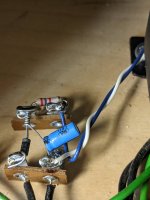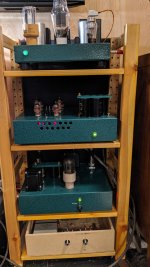I split my amplifier into two chassis for a myriad of reasons but now I don't have access to the voltage I need to run my led power indicator. I was thinking running it off of an AC heater circuit I have would be perfect given the ac signal being close to 3 volts due to the diode effect of the led.
I am a little concerned with introducing noise since the led will be switching on and off at 60hz. ( or maybe 120hz?)
So is there an easy way to isolate it so it can't put any noise into the heater line or am I worrying about nothing?
Jeff
I am a little concerned with introducing noise since the led will be switching on and off at 60hz. ( or maybe 120hz?)
So is there an easy way to isolate it so it can't put any noise into the heater line or am I worrying about nothing?
Jeff
> I was thinking running it off of an AC heater circuit
It needs a series resistor, couple hundred ohms, to control current.
I have run LED on heater power without audible buzz.
However if you move your head fast, you will see the flicker.
Modern LEDs are SO efficient that they often are bright enough with 1mA. Which may be 270k 1/2W from a 250V DC rail.
It needs a series resistor, couple hundred ohms, to control current.
I have run LED on heater power without audible buzz.
However if you move your head fast, you will see the flicker.
Modern LEDs are SO efficient that they often are bright enough with 1mA. Which may be 270k 1/2W from a 250V DC rail.
This was a 16v winding. Adjust your resistor for 2v to the LED (which is at the end of the white and blue wires.View attachment 910008
So the neg stripe on the cap is on the white wire right? What is best like a 220uf?
> I was thinking running it off of an AC heater circuit
It needs a series resistor, couple hundred ohms, to control current.
I have run LED on heater power without audible buzz.
However if you move your head fast, you will see the flicker.
I was surprised long ago to find that an amp I had bought randomly had power LEDs connected to the 6.3V AC heater winding with just a series resistor. It seemed to work just fine!
I've already used that trick of the led from the heaters and I confirm it just flicks a bit, but works properly.
This was a 16v winding. Adjust your resistor for 2v to the LED (which is at the end of the white and blue wires.View attachment 910008
Hi it is right to adjust for the maximum current you want through the LED as their forward voltage follows according the known properties of LED. Modern ones start to glow with around 1 mA and their Uf is around 1.6 - 1.8V depending on color. If does not want the whole room to be lit one could calculate with 2.5 mA for the green/amber/red ones. White/blue/purple and all the "blue LED derivatives" have higher Uf of between 3 and 4V. I don't know about their current as I don't use these but a datasheet may help.
(Ubat - Uled - Uf diode)/Iled = R
A diode (to protect the LED from AC and give the LED a longer service life) and current limiting resistor are the bare minimum but the cap you added prevents 50 or 60 Hz flickering which is nice. LEDs die from a too high reverse voltage which is why they don't live long without the series diode.
When the power transformer is a toroid and no suitable winding for a LED is there one can add a few turns isolated copper wire just to power a LED......
Attachments
Last edited by a moderator:
I've connected my blue LED power indicator to the negative DC supply (for bias); haven't seen such approach before, but hope it's correct -> indicates bias presence before plate voltage appearance (delayed).
BR
BR
Last edited:
>
Modern LEDs are SO efficient that they often are bright enough with 1mA. Which may be 270k 1/2W from a 250V DC rail.
I have a blue LED that is blinding powered from 12V through a 1M resistor. Efficient indeed!
It all depends on what one calls efficient 🙂 Burning 0.23W to light a 1 mA LED ( = 1.6 mW) is IMO not efficient. That is why connecting them to a 6.3V winding or lower DC voltage is preferred.
Last edited:
Use a two pin bicolor (bidirectional) LED like one of these , plus a series resistor for current limiting. This indicator flickers at "120 frames per second", far far faster than the 24 frames per second of motion pictures projected in the cinema.
The two back-to-back diodes protect each other against excess reverse bias, and the series resistor protects against overcurrent. Quick, easy, safe, and only two components.
The two back-to-back diodes protect each other against excess reverse bias, and the series resistor protects against overcurrent. Quick, easy, safe, and only two components.
What exactly is gained by using a bidirectional LED (colorwise)? If ease of use is a goal the front panel mount LEDs with series resistor already built in (like Dialight 559 series) are as easy to use and only emit one color. They would need the series diode so just as quick, easy, safe, and also only two components. Better looking as well as these have the panel mount ring already with them and they are wired and finished the safe and neat way.
Last edited:
Simply attaching the LED in series with the power supply bleeder resistor gives you a free power light, and a shock hazard indicator, too!
FWIW I've never had an LED require a series diode for low voltages (<30V). Yes, it will flicker at line frequency which kills me so a small cap and a bridge made from 1n4148 is usually employed if I use the heater winding for the LED.
FWIW I've never had an LED require a series diode for low voltages (<30V). Yes, it will flicker at line frequency which kills me so a small cap and a bridge made from 1n4148 is usually employed if I use the heater winding for the LED.
Last edited:
Shock hazard yes, with only 1 resistor and then connected to several hundreds of DC Volts carrying thin wires routed to a front panel LED...
Tube safety, as usual 🙂
Tube safety, as usual 🙂
Last edited:
They make em every day. I see no issue running HV to the front panel. There are other thin wires carrying that same voltage to other places inside the same metal box, right?
Casing also not connected to PE? That is the usual combination of the guild.
In the case of pilot LED lights like Dialight types the wires are very thin (hopefully the wiring for the circuits is somewhat thicker with thicker isolation as well) and I would not route hundreds of DC Volts via them and why would anyone route higher voltage wires to a front panel just for a LED? No sane person would drop 250V over just 1 resistor and accept the risk...... It is simply bad design and unsafe. Many brands therefor just connect the LED to the filament supply as was the original topic.
Yes when using a diode bridge you already have the AC protection as a bonus. LEDs don't like too high reverse voltages so you did it right (coincidentally). Connecting a LED just with a resistor to AC is not OK in general (depends on how high voltage is) as it will then see a reverse voltage. In DC circuits they don't need a diode in series of course.
In the case of pilot LED lights like Dialight types the wires are very thin (hopefully the wiring for the circuits is somewhat thicker with thicker isolation as well) and I would not route hundreds of DC Volts via them and why would anyone route higher voltage wires to a front panel just for a LED? No sane person would drop 250V over just 1 resistor and accept the risk...... It is simply bad design and unsafe. Many brands therefor just connect the LED to the filament supply as was the original topic.
FWIW I've never had an LED require a series diode for low voltages (<30V). Yes, it will flicker at line frequency which kills me so a small cap and a bridge made from 1n4148 is usually employed if I use the heater winding for the LED.
Yes when using a diode bridge you already have the AC protection as a bonus. LEDs don't like too high reverse voltages so you did it right (coincidentally). Connecting a LED just with a resistor to AC is not OK in general (depends on how high voltage is) as it will then see a reverse voltage. In DC circuits they don't need a diode in series of course.
Last edited:
I used the diode bridge because I didn't like the flicker. The LED will flicker away for years running on a 6VAC supply though.
And in my case, the casing is always connected to PE unless it's powered by a 12V brick that isolates it's output.
And in my case, the casing is always connected to PE unless it's powered by a 12V brick that isolates it's output.
A few minutes ago you said they survive reverse voltages <30V which is simply not true for many LEDs. First you said to use them on the HV DC part. Then you said you can't stand the flicker (wich indicates AC and low voltage) and use rectifier and cap to avoid that. Then you said they flicker for years on 6V AC.... Keep contradicting about a simple LED 😀, I go outside. Cheers!
FWIW I've never had an LED require a series diode for low voltages (<30V).
Last edited:
1: They do survive less than 30V (without using a diode in series). (I see now I put a greater than symbol by mistake or did I? My brain hurts today). I've even had one run off 120VAC for years using a 22k resistor only (we used to make a light for the light switch when we were kids so our parents could see where the switchplate was in the dark). YMMV? Not all LEDs are the same, obviously.
2: Yes I use them on the HV supply. It's DC. No diode needed.
3: Yes, when I do use it from the AC heater supply, it flickers so I use a bridge and cap to get rid of it - nothing to do with protecting the LED from excessive PIV.
4: They WILL work and flicker for years if you run them from a 6V AC supply using a dropping resistor.
What didn't you understand besides my < instead of > error?
2: Yes I use them on the HV supply. It's DC. No diode needed.
3: Yes, when I do use it from the AC heater supply, it flickers so I use a bridge and cap to get rid of it - nothing to do with protecting the LED from excessive PIV.
4: They WILL work and flicker for years if you run them from a 6V AC supply using a dropping resistor.
What didn't you understand besides my < instead of > error?
Last edited:
This LED unit is what I usually go for. Large range of voltages and has a resistor and diode built in. I see no flicker and I usually do not like LEDs but these have a little old school look to them.
https://vcclite.com/wp-content/uploads/wpallimport/files/files/1091M.pdf
https://vcclite.com/wp-content/uploads/wpallimport/files/files/1091M.pdf
Attachments
- Home
- Amplifiers
- Tubes / Valves
- LED power indicator from heater circuit


